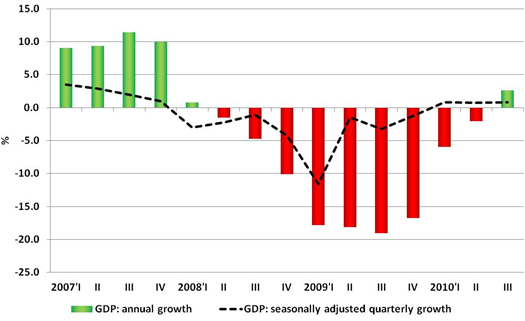Annual growth posted for gross domestic product; for continued growth decisive steps required
According to the flash estimate published by the Central Statistical Agency (CSP), gross domestic product (GDP) in comparative prices grew 2.7% year-on-year in the third quarter. That marks this as the first quarter with a positive, albeit moderate GDP growth since the first quarter of 2008. The annual growth was primarily ensured by the rapid increase (19.4%, according to data adjusted to the number of working days) in the industrial production volumes based on foreign demand. A return to annual growth - of 2.2% - was observed also in trade. The GDP quarterly growth, by seasonally adjusted data, was 0.8% in the third quarter.
Despite these positive developments, however, several factors point to the need to remain cautious as far as the GDP future dynamics is concerned. Among such factors is the decrease in the seasonally adjusted quarterly growth rate in the industrial sector (7.1% in the second quarter, 4.7% in the third) and in retail trade (3.6% and 1.0% respectively). The confidence indicators monitored by the European Commission also point to the fact that the industrialists are more pessimistic regarding the opportunities for production exports in the future; the upward trend in the full load of production capacity has stopped, and this suggests that the industrial growth may abate. In addition, there are increasing concerns over the growth potential of the global economy, as a result of which a good part of the predictions regarding 2011 have been revised downward, and that of course may have an effect on Latvia's export potential.
In such circumstances, the developmental dynamics of the economy will to a great extent be determined by the adoption of the 2011 budget and the nature of its accompanying consolidation measures. It will be particularly important if the necessary fiscal consolidation is accomplished at the expense of the seemingly easier broadening of tax rates and taxable base or the leaders of economic policy are able to cut state budget expenditure.
A further raising of tax rates would have a negative effect on the economic recovery process, dealing a blow to the business and investment environment. Cutting budget expenditure, on the other hand, would have a positive effect both on state finances and the competitiveness of the economy, which would be essential for further growth of the economy should foreign demand slacken. Furthermore, to ensure economic growth in the medium term, there is a need for investments that have shrunk rapidly and are still below the pre-crisis level. Among the most important factors determining the investment environment is a stable and predictable tax policy and for that reason it is not advisable to make rapid changes in tax rates or the size of the tax base. Only a reasonable decrease in expenditure along with structural reforms will provide the necessary impact on the economy serving as a signal to both local and international market participants that the Latvian economy is continuing to improve its competitiveness and investment environment and is doing it sustainably.
More detailed statistical information that will provide a more comprehensive picture of both the stimulating and hindering factors by sector and usage components will be published by CSP on 9 December.
Figure - CSP data.

Textual error
«… …»




